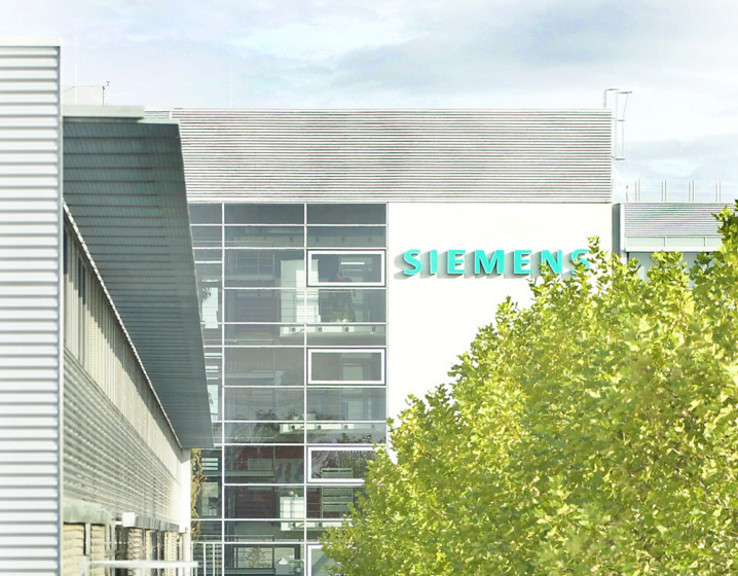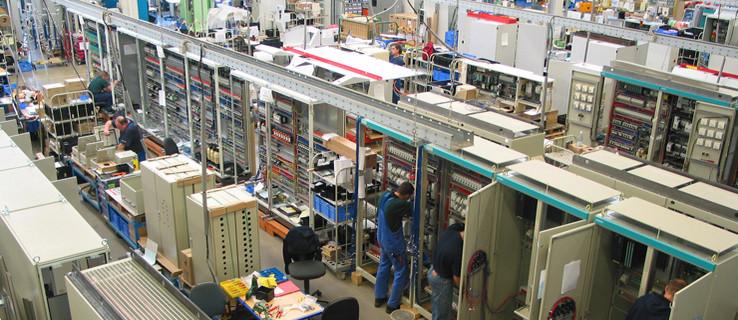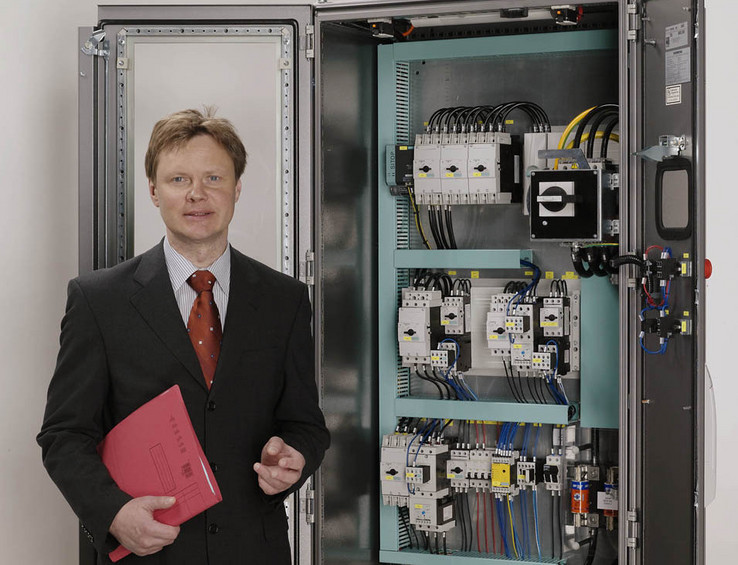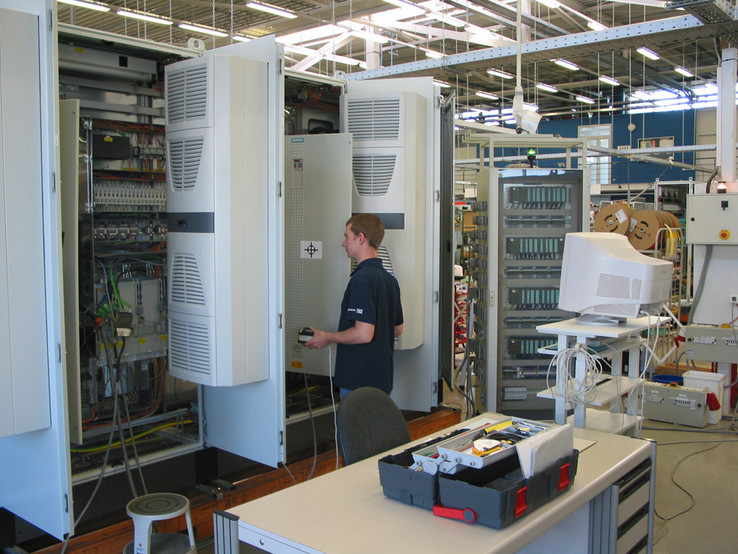EPLAN Cabinet at Siemens in Chemnitz
Siemens has created an integrated information flow from SAP via EPLAN Electric P8 through to EPLAN Cabinet
The Siemens combination engineering plant at Chemnitz, which develops and produces control cabinets for more than 130 customers, uses EPLAN Cabinet for its 3D planning. In order to accelerate work operations and respond quickly to differing order and customer requirements without compromising its high quality standards, Siemens has also created an integrated information flow from SAP via EPLAN Electric P8 through to EPLAN Cabinet. “From control cabinet production to solutions factory”: This is the motto of the Siemens site in Chemnitz. WKC, the combination engineering plant, develops and manufactures electronic assemblies and complete cabinets, with exceptional success: The plant boasts more than 130 clients, nationwide and worldwide. Anyone who operates in the highly competitive environment of control cabinet production needs to offer their customers something special if they are to be successful. Engineer Hans-Peter Kasparick, Head of Specialist Tasks/Software Engineering at Siemens Chemnitz, explains: “We distinguish ourselves from our competitors because as partners to the customer, we cover the entire value-added chain: We collaborate with our customers very early in the development phase, and if required, can produce complete automation concepts. For on-going series, we work tirelessly to achieve cost optimisation of the switchgear".
Increasingly important: Production of small series and one-offs
WKC is also very flexible when it comes to production: Of the 14,000 or so control cabinets that leave the factory each year, many are only produced in small quantities via the one-off process. In such cases, efficient planning and production is particularly important. With this in mind, Siemens has worked hard to establish an integrated information flow which begins as soon as the customer submits the first project documents. Hans-Peter Kasparick explains: "We receive a wiring schematic and a bill of materials from our customers, and usually a layout proposal as well”.
Communication between ECAD und ERP
Because throughput time is a decisive factor in control cabinet manufacturing – and short throughput times translate into a competitive lead - Siemens checks the plausibility of the documents in advance, e.g. by comparing the bill of materials and wiring schematic. Hans-Peter Kasparick explains: “Our aim is to begin production without any incorrect parts, in order to guarantee planning and process reliability in production”. First, the bills of materials are transferred into a self-developed, easy-to-use software package for bill of materials administration, and from there into the SAP system. These bills of materials may then in turn – and this is where modern E-CAD technology comes into play – be transferred into the EPLAN Electric P8 system. At this point, the database structure of the new EPLAN software really comes into its own: Without this structure, it would not be possible to implement the interaction between ECAD and ERP (Enterprise Resource Planning) so easily.
From wiring schematic to finished enclosure
In a subsequent stage, the Siemens engineers convert the wiring schematic into technological production documents. One of them is the mechanical layout plan of the switchgear. In the past, this was implemented in 2D technology, but now they work three-dimensionally, based on the EPLAN data, with EPLAN Cabinet. This new software based on the new EPLAN Platform was designed especially for the project planning of mounting plates and control cabinets. The intuitive interface and intelligent engineering tools make the engineer’s work easier. Cable ducts, support rails, terminals, contactors etc. are easily positioned at a click of the mouse. The system makes allowances for minimum spacings and blocked surfaces; an online collision control facility helps to avoid positioning errors. The basic module may be extended to include additional functions e.g. for routing and for the generation of production data for machining.

State-of-the-art: Siemens in Chemnitz sets technological standards – and that also includes engineering with the EPLAN Platform.
Three-dimensional engineering
It makes sense to add a third dimension to engineering, not least because control cabinets are becoming ever more complex: Increasingly, components are being positioned on assemblies, doors, bases and side panels; the 3D view avoids collisions and ensures the required component clearances. A second argument is even more convincing: in view of the limited construction space and ever-increasing output of components, greater consideration needs to be given to thermal design and heat dissipation. For this reason, the Technical Competence Centre Cabinet Cooling, based at the Chemnitz plant, is dedicated solely to this problem. As a service, this team collaborates with the customer to devise thermal solutions, implement optimizations and measurements, and perform type testing with proof of compliance with environmental specifications. In this connection, EPLAN Cabinet usefully offers an interface to the thermosimulation software used by Siemens, which is capable of emulating thermal distribution and dissipation in the control cabinet. This requires a 2D interior view of the cabinet. EPLAN Cabinet supplies this geometric data to the program. The engineer can input an ambient temperature and calculate whether the planned layout is correct from a thermal viewpoint. In addition to this link option, Siemens also makes use of other interfaces, such as those to its in-house component library and to the libraries of various other suppliers such as Rittal (RiCAD 3D/selection of enclosures) – here too, the aspect of integration plays a key role.
High quality, faster processes
The central component administration feature in the EPLAN Platform is a genuine advantage for Siemens, because the integrated database allows optimum preparation of the production processes to a high quality standard, and also paves the way for short preparation times. Hans-Peter Kasparick explains: “For us, the greatest potential for time savings and cost cuts lies in the preparation process, i.e. in the engineering; EPLAN Cabinet helps us to tap into this potential”. Many third-party products are already stored in EPLAN, and others are due to follow shortly. The company’s preferred suppliers have been asked to supply 3D data with dimensions, attachment points etc. which will then be fed into the database.
Customized module makes engineering easier for one-offs
When planning one-offs, Siemens has collaborated with EPLAN to incorporate an additional labor-saving feature: A similar project with many identical parts is used as a basis, and EPLAN Cabinet automatically compares the current data from the EPLAN bill of materials with the new project. In Siemens’ experience, this approach offers significant time savings in engineering, which in turn translates into a competitive advantage, since the module was custom-designed for Siemens.
Link to mechanical production
Siemens delegates machining of the cabinets to local suppliers. Cabinets are delivered with an NC file generated by EPLAN Cabinet – or more specifically, by the NC module – which the suppliers are able to load into their machines, containing precise data for the drilling and laser-cutting of holes and cutouts and for the production of mounting plates. In this way, mechanical engineering and ECAD are growing ever closer together.
In future: Plans for pre-assembled cables with routing function
Using EPLAN as a basis, Siemens has therefore implemented an integrated information flow for the entire engineering and production chain; the interface to bill of materials administration and to SAP also facilitates a link to commercial activities such as procurement and cost accounting. In the near future, the Siemens Chemnitz plant is planning to integrate additional process stages into the ECAD software. For example, they intend to use pre-assembled cables that are planned using a routing program, available as an EPLAN Cabinet module. This will help to significantly shorten throughput times.
Marketing benefits
There are also a number of “soft” factors in favor of 3D control cabinet planning with EPLAN Cabinet. Hans-Peter Kasparick explains: “The 3D view is an excellent marketing tool. The customer is able to visualize his product early on and has a better idea of the appearance of the cabinet – this is important in view of the growing emphasis on design aspects in mechanical engineering.” Siemens also offers an additional service for customers who like to know exactly what is going on: They can keep an eye on the current status of their enclosure via a webcam and discuss technical details of the configuration.




